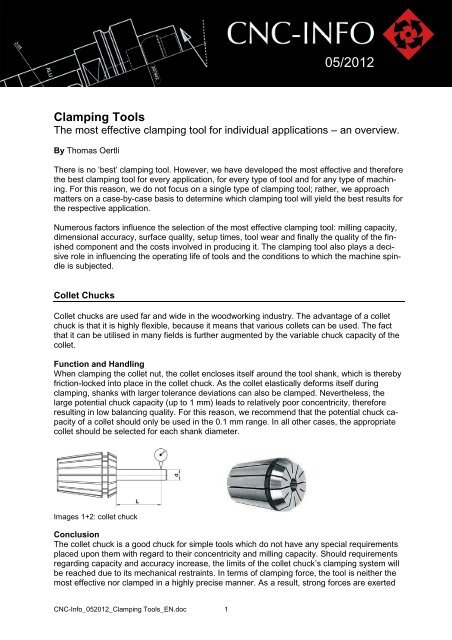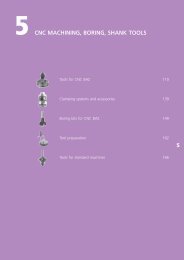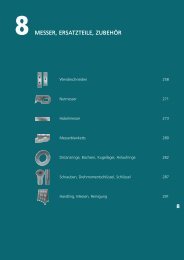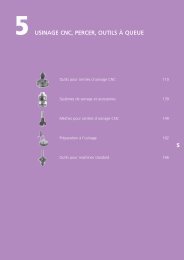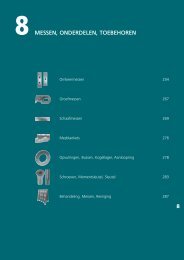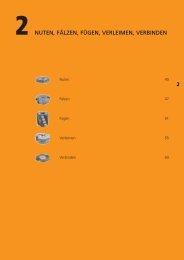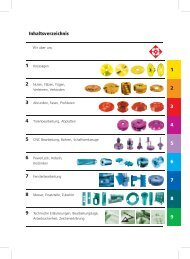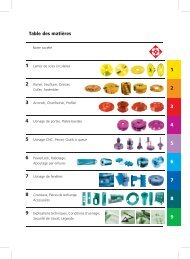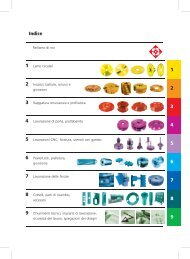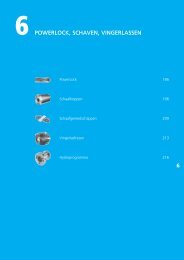Clamping Tools
Clamping Tools
Clamping Tools
Create successful ePaper yourself
Turn your PDF publications into a flip-book with our unique Google optimized e-Paper software.
05/2012<br />
<strong>Clamping</strong> <strong>Tools</strong><br />
The most effective clamping tool for individual applications – an overview.<br />
By Thomas Oertli<br />
There is no ‘best’ clamping tool. However, we have developed the most effective and therefore<br />
the best clamping tool for every application, for every type of tool and for any type of machining.<br />
For this reason, we do not focus on a single type of clamping tool; rather, we approach<br />
matters on a case-by-case basis to determine which clamping tool will yield the best results for<br />
the respective application.<br />
Numerous factors influence the selection of the most effective clamping tool: milling capacity,<br />
dimensional accuracy, surface quality, setup times, tool wear and finally the quality of the finished<br />
component and the costs involved in producing it. The clamping tool also plays a decisive<br />
role in influencing the operating life of tools and the conditions to which the machine spindle<br />
is subjected.<br />
Collet Chucks<br />
Collet chucks are used far and wide in the woodworking industry. The advantage of a collet<br />
chuck is that it is highly flexible, because it means that various collets can be used. The fact<br />
that it can be utilised in many fields is further augmented by the variable chuck capacity of the<br />
collet.<br />
Function and Handling<br />
When clamping the collet nut, the collet encloses itself around the tool shank, which is thereby<br />
friction-locked into place in the collet chuck. As the collet elastically deforms itself during<br />
clamping, shanks with larger tolerance deviations can also be clamped. Nevertheless, the<br />
large potential chuck capacity (up to 1 mm) leads to relatively poor concentricity, therefore<br />
resulting in low balancing quality. For this reason, we recommend that the potential chuck capacity<br />
of a collet should only be used in the 0.1 mm range. In all other cases, the appropriate<br />
collet should be selected for each shank diameter.<br />
Images 1+2: collet chuck<br />
Conclusion<br />
The collet chuck is a good chuck for simple tools which do not have any special requirements<br />
placed upon them with regard to their concentricity and milling capacity. Should requirements<br />
regarding capacity and accuracy increase, the limits of the collet chuck’s clamping system will<br />
be reached due to its mechanical restraints. In terms of clamping force, the tool is neither the<br />
most effective nor clamped in a highly precise manner. As a result, strong forces are exerted<br />
CNC-Info_052012_<strong>Clamping</strong> <strong>Tools</strong>_EN.doc 1
upon the tool and the chuck during machining. The tool is inaccurate in its operation, leading<br />
to the chuck and tool being subjected to a significant amount of stress and therefore increased<br />
wear. The quality of the finished work is also adversely affected.<br />
Handling:<br />
Performance:<br />
Investment:<br />
Expansion Chucks: SINO and Hydraulic<br />
Excellent damping properties<br />
A result of the machining process, vibrations affect the operating life of tools and machine<br />
spindles. Thanks to the special design of the SINO and hydraulic clamping chucks, these vibrations<br />
are reduced. The vibration damping effect does not just lead to a reduction in microblowouts<br />
along the tool’s cutting edge and less wear and tear; it also improves the smooth<br />
running of the tool at the same time. This extends the operating life of the tool, protects the<br />
machine spindle and clearly improves the surfaces of the component.<br />
Concentric accuracy<br />
The concentric and repeat accuracy is an excellent < 0.005 mm for the hydraulic chuck and<br />
SINO chuck.<br />
Comparing the SINO and hydraulic chucks<br />
The SINO and hydraulic clamping chucks offer a comparably high performance for the same<br />
price. The differences lie in the technical design and handling. The SINO clamping chuck requires<br />
a mounting fixture in order to mount the milling cutter on the clamping chuck. In contrast,<br />
a simple T-handle wrench is sufficient for installing the hydraulic clamping chuck.<br />
SINO <strong>Clamping</strong> Chuck<br />
The SINO clamping chuck consists of an interface on the machine (normally the HSK 63F)<br />
and an extension sleeve integrated into the chuck. The chamber for the extension sleeve is<br />
filled with an elastic material which serves as a pressurising medium.<br />
Function and handling<br />
In order to mount the tool, it must be fixed in a clamping<br />
block; the clamping tool is then released using a<br />
hook wrench, and the tool shank is inserted. By axially<br />
tightening the flare nut, the necessary pressure is exerted<br />
upon the extension sleeve, and the tool is<br />
clamped. During the clamping process, the flare nut is<br />
tightened until it reaches the shaft inset (and therefore<br />
a planar contact area). The whole system is further<br />
reinforced thanks to the flare nut’s contact with this<br />
Cross-section of the SINO <strong>Clamping</strong> Tool<br />
area, and the stability of the system increases accordingly.<br />
This results in a strong clamping force and excellent<br />
concentric accuracy.<br />
Conclusion<br />
The SINO clamping chuck is suitable for directly clamping shank-type tools with cylindrical<br />
shafts which have a diameter of 12, 16, 20 or 25 mm. Adaptor sleeves can be used for intermediate<br />
dimensions<br />
CNC-Info_052012_<strong>Clamping</strong> <strong>Tools</strong>_EN.doc 2
(i.e. shaft diameters of 3 to 20 mm). However, adaptor sleeves impair the clamping quality and<br />
reduce the high precision of the clamping chuck.<br />
Handling:<br />
Performance:<br />
Investment:<br />
Hydraulic <strong>Clamping</strong> Chuck<br />
The hydraulic clamping chuck is a universal clamping chuck for precisely clamping tools with<br />
cylindrical shafts. A hydraulic fluid is located inside the hydraulic clamping chuck, which is encased<br />
in an annular gap around the borehole.<br />
Function and handling<br />
The hydraulic fluid is condensed by means of a hydraulic clamping set (pressure screw, pressure<br />
pin and seal) and a hexagonal T-handle wrench. The resulting pressure causes a uniform<br />
deformation to occur within the extension sleeve. Through this, the tool shank is clamped with<br />
high concentric accuracy. Thanks to the closed construction, the hydraulic sleeve does not<br />
require maintenance and can be immediately used without the need for any auxiliary tools or<br />
tool mounting fixtures. By turning the T-handle wrench until it reaches a fixed shaft inset, pressure<br />
is built up via the valve, and the tool shank becomes centred and clamped within seconds.<br />
In order to remove the tool, the screw is turned back a couple of times. The pressure is<br />
reduced and the tool can be removed.<br />
Conclusion<br />
The hydraulic clamping chuck is suitable for precisely<br />
and directly clamping shank-type tools with cylindrical<br />
shafts which have a diameter of 12, 16, 20 or 25 mm.<br />
SINO clamping chuck adaptor sleeves can be used for<br />
intermediate dimensions (i.e. shaft diameters of 3 to 20<br />
mm). However, adaptor sleeves impair the clamping<br />
quality and reduce the hydraulic clamping chuck‘s extremely<br />
high precision. As such, adaptor sleeves are<br />
Cross-section of the hydro-clamping tool<br />
not recommended.<br />
As the tool can be clamped and released using a simple T-handle wrench without the need for<br />
any major manual effort, a mounting fixture is not necessary. As a result, a change of tools is<br />
easy to carry out and can be completed in seconds.<br />
Handling:<br />
Performance:<br />
Investment:<br />
Shrinkage<br />
Shrink-fit chucks are especially slim and do not have any kind of mechanical or movable parts.<br />
Various clamping chuck contours can be modularly constructed with extensions and reducers,<br />
CNC-Info_052012_<strong>Clamping</strong> <strong>Tools</strong>_EN.doc 3
thereby allowing cutting to be carried out in places on a component which are difficult to access.<br />
Thermal shrink-fit chuck<br />
The thermal shrink-fit chuck is highly convincing thanks to its very high concentric<br />
accuracy, optimum friction-locked connection between the tool and<br />
the holding fixture, extremely low weight, and slim design.<br />
Function and handling<br />
The chuck is heated up in the thermal shrink-fit device. The tool can be<br />
inserted by means of radial expansion. The tool then becomes securely<br />
clamped when the chuck cools and the radial shrinkage is at a normal level.<br />
As the material is only elastically deformed during the shrinking process<br />
and therefore always returns to its original form, in practice the shrinking<br />
process can be infinitely repeated.<br />
Thermal shrink-fit<br />
chuck<br />
Conclusion<br />
The thermal shrink-fit chuck is suitable for clamping tools with cylindrical shafts in a highly precise<br />
manner. If you require the highest level of precision and performance and the modular<br />
use of extensions and/or reducers, and you are willing to allow the shrinking process to be<br />
carried out using an in-house shrink-fit tool or via your tool partner, this is the right clamping<br />
tool for you. OERTLI’s facility in Höri, Switzerland, is fitted with the most cutting edge equipment<br />
and will carry out the change of tools if required.<br />
Handling:<br />
Performance:<br />
Investment:<br />
Force shrinkage<br />
The TRIBOS clamping tool is based on the principle of force shrinkage. It provides effective<br />
conditions for machining tasks in or on areas of the component which are difficult to access,<br />
i.e. it is an application which conventional clamping systems can no longer be used for.<br />
Function and handling<br />
The TRIBOS clamping principle utilises the internal stress of the steel. This is cylindrical due<br />
to the specific deformation of the polygon-shaped mounting hole. In this state, the tool shank<br />
can be inserted. When the pressure is reduced, the tool is friction-locked via the internal stress<br />
of the steel. A special clamping fixture is required in order to mount the tool.<br />
Cross-section of the TRIBOS clamping tool<br />
CNC-Info_052012_<strong>Clamping</strong> <strong>Tools</strong>_EN.doc 4
Conclusion<br />
The TRIBOS clamping tool is only offered by OERTLI on special request by the customer. The<br />
TRIBOS’s performance is less effective than that of the hydraulic clamping chuck and SINO<br />
clamping chuck, and offers very few advantages in comparison.<br />
Handling:<br />
Performance:<br />
Investment:<br />
Minimum clamping length<br />
For all OERTLI CNC tools, the minimum clamping length is<br />
labelled by the symbol K. Important: the minimum clamping<br />
length labelled on the shank corresponds to European<br />
safety requirements and is therefore not the most suitable<br />
clamping length – it only represents the minimum length!<br />
The shank should be clamped within the chuck as deeply<br />
as possible, and the degree to which the tool protrudes<br />
from the chuck should be kept to a minimum.<br />
Figure 1: according to the standard (not ideal)<br />
Figure 2: optimum clamping (ideal!)<br />
Figure 3: shank clamped too deeply within the chuck (not<br />
ideal)<br />
Figure 1<br />
Figure 2<br />
Figure 3<br />
CNC-Info_052012_<strong>Clamping</strong> <strong>Tools</strong>_EN.doc 5


